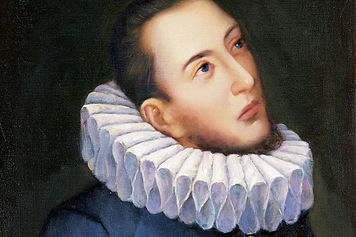Gesualdo: Rebel or Rogue? [with Audio]

On February 16, at 7:30 p.m. at St. Francis of Assisi Church, the University Musical Society presents the Tallis Scholars. This British group of about ten singers has spawned a whole industry of a cappella ensembles that aspire to sonic purity, contemplative calm, timelessness. What could the Tallis Scholars—Scholars!—possibly have to do with this season’s Pure Michigan Renegade Series, of which they are a part?
Let’s start with the gruesome facts associated with the composer at the center of the night’s program. Carlo Gesualdo (1566?–1613), the nephew of Counter Reformation enforcer Carlo Borromeo, was a prince and landholder in Venosa in southeastern Italy. Around 1588 his wife, the noblewoman Donna Maria d’Avalos, began an affair with a gentleman in the vicinity. In 1590 Gesualdo, using wooden copies of room keys he had had made, found the pair in bed together, stabbed them both, and hung their corpses in front of his castle for all to see. The story was retold repeatedly by poets of the day in a sixteenth-century equivalent of headline news.
Gesualdo, as a nobleman, was immune to prosecution, although he had plenty to fear from the relatives of his wife and her lover. He was never arrested, but he spent most of the rest of his life either on the road, investigating new musical developments, or, later on, locked up in his castle, writing music for concerts at which he himself was the audience.
The madrigals he wrote during his later years lay buried for three hundred years, but they fascinated musical modernists who unearthed them. Filled with hyper-expressive settings of texts about searing jealousy and betrayal, they seemed to push the boundaries of dissonance that was possible under the rules of Renaissance polyphony, and to anticipate music that was centuries in the future. The first performers of the madrigals, in fact, were mostly not early music specialists but the group of performers led by Robert Craft, the prominent American champion of Igor Stravinsky’s music.
Gesualdo wrote less sacred music, but the Tenebrae Reponsories (“tenebrae” means “shadows” and refers to Christian services celebrated in the days before Easter; a responsory is a setting of a text that contains an answering section) that he composed at the end of his life are among his very greatest works. In these pieces the thorny question of how Gesualdo’s life and music are related reaches an especially sharp point. Consider this setting of “O vos omnes” composed by Gesualdo in 1611, two years before his death:
“O vos omnes qui transitis per viam, attendite et videte si est dolor similis sicut dolor meus,” says the responsory text—”O you who walk down the road, pay attention and see whether there is any sorrow like my sorrow.” The text comes from the Lamentations of the Prophet Jeremiah and originally described the sack of Jerusalem in the sixth century B.C.E. It was repurposed for the Passion story. But it’s hard not to think of Gesualdo himself as the subject when the words “similis sicut dolor meus” are repeated in tonal regions unthinkably distant from the piece’s home base.
*****
Was Gesualdo really a renegade as well as a murderer? Was he even a “modernist” of his time? Some would say no — his chromaticism did not lead to a new language but only explored the strangest corners of an old one. The truly new music of the first decade of the 1600s was opera, which he did not touch. Gesualdo’s music was closed up in an emotional hothouse, and one word that’s been used to describe it is Mannerist — looked at from a certain angle, the jarring contrasts in his works were musical equivalents of El Greco’s light and shade. Or perhaps his artistic counterpart was Giuseppe Arcimboldo, the Italian who painted surreal human heads made up of vegetables, plants, and even books.
Photo: Giuseppe Arcimboldo’s Vertumnus.

What is a renegade, anyway? Does change in the arts come from an avant-garde, or does it bubble up from below? Do musical traditions tend to shock most when they begin, or when they’re coming to an end?
Whatever your ultimate answers to these questions may be, the music of Don Carlo Gesualdo has lost none of its ability to shock as it enters its fifth century of existence. If you’ve never heard Gesualdo at all, or if you know him only through the few tortured madrigals that circulate among college singing groups, hear how the language of his last years was refracted through sacred texts in the magnificent Tenebrae Responsories, somber Holy Week thoughts from a prince whose life and music intertwined in profound ways.






